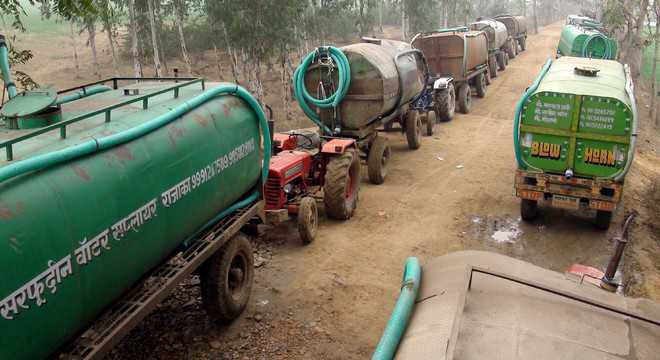
Owing to severe water crisis, districts like Mewat are primarily dependent on tankers to quench their thirst. Tribune Photo
Sumedha Sharma
Tribune News Service
Gurugram, June 19
The Niti Aayog’s latest report titled “Composite Water Management Index” says Delhi, along with 20 other cities, will be left without groundwater by 2020.
This has rung alarm bells for Gurugram, which is only 20 km from Delhi. In the last decade, the city witnessed a decline of 82 per cent in its water table. And in the past 40 years, more than 250 natural water bodies have gone dry. It is high time that the city addresses the danger of prospective “aqua-calypse”, experts say.
Though the Central Ground Water Authority (CGWA) had declared Gurugram as a “dark zone” in 2008 and advocated urgent steps to boost the city’s water table, nothing much was done. The situation continued to worsen with realty boom and ever-increasing demand-supply gap.
At present, the city’s groundwater extraction is at 308 per cent, outstripping neighbouring Faridabad (75 per cent), Palwal (80 per cent) and Mewat (85 per cent).
The district administration was successful in dealing with illegal boring. But given the ever-increasing demand for water, check on illegal boring has been rendered helpless.
One of the major factors leading to depletion of groundwater is the lack of optimum recharge even after good monsoon. This is because of a majority of natural water bodies and recharge zones have been lost due to mindless concretisation, experts say.
The number of bodies, including those in Aravallis, stood at 519 in 1976. Today, the count is 251. The figures have been released by the local administration that conducted a study.
A few decades ago, the city — with more than 100 storm water drains — had a unique drainage system, but majority were encroached upon, putting the city to risk of flash floods like the city witnessed in 2016.
The four major water reservoirs — Ghata (50-ft deep) Nathupur (30-ft deep), Chakkarpur (12-ft deep) and Jharsa (10-ft deep) — used to store rainwater and recharge groundwater, thereby preventing waterlogging. The British built 118 check dams around natural lakes in Gurugram, Faridabad, Mewat and surrounding areas to control flooding during monsoon and to recharge groundwater. It served the area well, until the 1950s.
However, catchment areas of Ghata, Jharsa and Badshapur have been encroached upon by the land mafia or by public infrastructure projects, while religious sites, community halls and illegal colonies have come up on former water bodies in Choma, Gurugram village and Carterpuri.



























